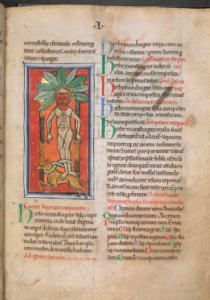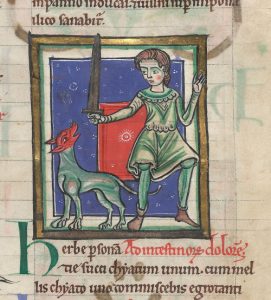When we consider a medieval manuscript, we often think about just the words within them and what the content of the book tells us. Illuminated manuscripts were an important medium for information during the Medieval period; they are the precursors of modern books. Within these manuscripts, there were large designs known as illuminations that accompanied textual information. These illuminations, coupled with a manuscript’s physical composition and size, provide a significant amount of information about the work beyond the text contained within it. In addition to physical characteristics, the ownership history of a manuscript, if it is available, can also clarify the purpose of a manuscript.
When we look at a manuscript, one of the first aspects we identify is size. This particular manuscript, Medical and herbal miscellany, is “300 x 200 mm,” or roughly 11.8 x 7.9 inches (London, British Library, Sloane MS 1975). Considering the size of a manuscript can lead us to several conclusions about its purpose and its general usage within a medieval society. This particular manuscript has information regarding various herbs and their medicinal uses. Considering its larger size (it would be difficult to carry around) the manuscript was probably used as a shelved reference in a physician’s office or within an apothecary’s shop. They would have been able to consult the manuscript to determine which herb would cure an ailment. Considering the manuscript also includes illuminations of accidents and other incidents that require medical treatments, that would lead us to believe that this manuscript was used as a medical reference and for the medicinal properties of specific herbs. It may also have been used as an educational tool, like a modern textbook. An aspiring physician could have utilized the text as a study reference. If the manuscript had been smaller, however, it might have been used by a botanist or another individual who was searching for these specific herbs.
The most visible aspect of all manuscripts are the pictures, or illuminations, contained within the book. Medical and herbal miscellany contains “over 200 [figures] of plants and animals” that are “in colors and gold and silver” (London, British Library, Sloane MS 1975).

The use of colors and precious metals in the manuscript suggests that it was created for someone very wealthy. Often, in religious texts or literary works of the period, illuminations are included to highlight specific themes that should be taken away from a manuscript. In many religious manuscripts, key themes of damnation and salvation are presented through images that depict monsters, people suffering, or the depths of hell. This allows illiterate people to still understand what a work was trying to communicate, even if they could not read it or if they did not have someone reading it to them.

However, this manuscript contains incredibly detailed pictures of plants, as well as illustrations of medical procedures and specific incidents that require medical treatment, like a rabid dog bite (right). Where a religious manuscript might include pictures to help communicate ideas to those who couldn’t read, this manuscript may include illuminations out of necessity; medicine is understandably complicated and it may have been the inclusion of the illuminations to supplement the text that further cements a physician’s understanding of medicine. Considering this point, this manuscript may also have been used as an educational tool to teach aspiring physicians. They could have learned medicine through the descriptions of the herbs, their functions, and how to apply them in different situations.
Another important aspect of a manuscript that is often used in historical reference is the binding, or the cover. Many manuscripts are not housed in their original bindings, and Medical and herbal miscellany is one of the manuscripts that has been rebound within its lifetime. While the original manuscript pages are dated to the “[late] 12th century,” the manuscript was rebound in the 17th century (London, British Library, Sloane MS 1975). The original binding may have been damaged, or the collector may have wanted to include other portions of a manuscript with this one. The newer binding could allude to the value of the work; if it was not a collector’s item or if it didn’t contain valuable information, effort would not have been put forth to bind it again.
Lastly, we can glean a lot of information about a manuscript’s purpose from those who purchased it. One of the last owners of this manuscript, before it was purchased by the British Museum, was Sir Hans Sloane; he was a “physician and collector” (London, British Library, Sloane MS 1975). He may have wanted a medical reference that provided information about medicinal herbs, or how people several centuries prior treated medical issues.
While books of herbal remedies and depictions of rabid dog attacks typically do not fit our mental image of a medieval illuminated manuscript, this particular manuscript seemed to serve an important purpose. In considering images and other physical aspects of the manuscript that go beyond textual evidence, we can discover more depth and meaning within these medieval works. At first glance, the appearance of many manuscripts may not suggest the depth and breadth of information held within them. Once we examine their origins and characteristics, however, we can discover the complete story they survive to tell.
Works Cited
“Sloane MS 1975.” Digitised Manuscripts, British Library, www.bl.uk/manuscripts/FullDisplay.aspx?ref=Sloane_MS_1975.
Wellesley, Mary. “Snakes, Mandrakes and Centaurs: Medieval Herbal Now Online.” Medieval manuscripts blog, British Library, 16 Sept. 2016, blogs.bl.uk/digitisedmanuscripts/2016/09/snakes-mandrakes-and-centaurs.html.